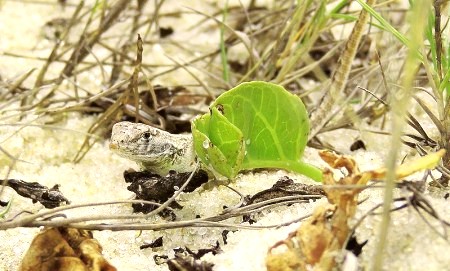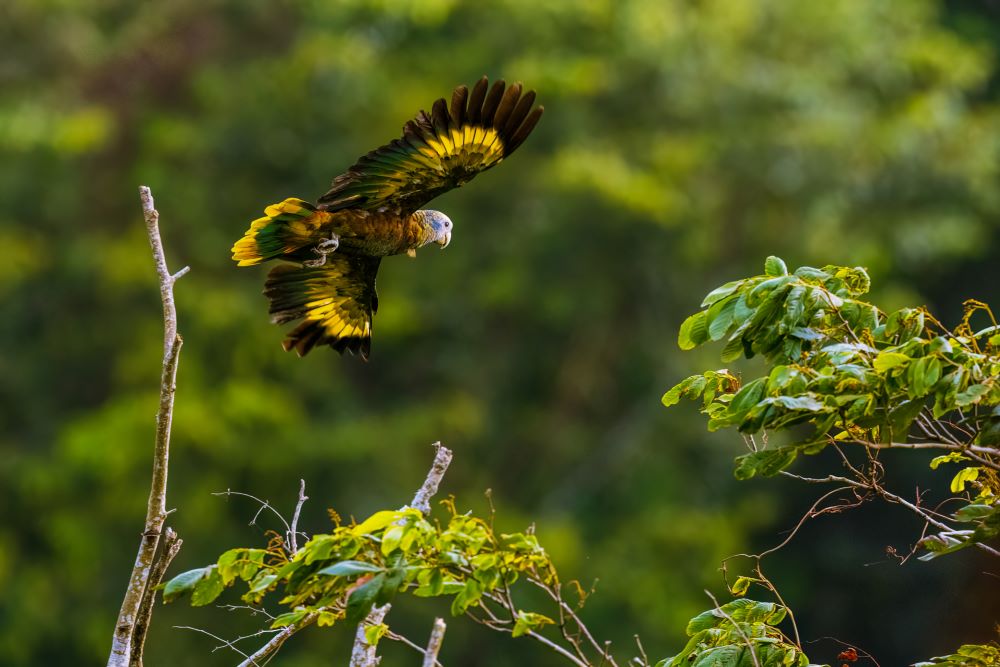

Lutz’s tree iguana (Liolaemus lutzae) is one of two Brazilian species on the list. Critically endangered, it inhabits a sandy coastal plain (restinga) in Rio de Janeiro State that has already seen a storm surge classified as a Level 1 tsunami (photo: Miguel Relvas Ugalde/Wikimedia Commons).
A study conducted by Brazilian scientists and colleagues in other countries shows that earthquakes, hurricanes, tsunamis and volcanic eruptions increase the risk of extinction for mammals, birds, reptiles and amphibians. The natural events may have synergies with hazards due to human activity.
A study conducted by Brazilian scientists and colleagues in other countries shows that earthquakes, hurricanes, tsunamis and volcanic eruptions increase the risk of extinction for mammals, birds, reptiles and amphibians. The natural events may have synergies with hazards due to human activity.

Lutz’s tree iguana (Liolaemus lutzae) is one of two Brazilian species on the list. Critically endangered, it inhabits a sandy coastal plain (restinga) in Rio de Janeiro State that has already seen a storm surge classified as a Level 1 tsunami (photo: Miguel Relvas Ugalde/Wikimedia Commons).
By André Julião | Agência FAPESP – In an article published in the journal PNAS, a group of researchers supported by FAPESP estimates that more than 3,000 species of terrestrial vertebrates are at risk of extinction due to earthquakes, hurricanes, tsunamis, and volcanic eruptions.
The authors selected all amphibian, bird, mammal and reptile species with a maximum population size of 1,100 mature individuals and/or a range of 2,500 square km or less (making reproduction difficult and recovery of population viability unlikely). They considered species to be at-risk of extinction if their range overlapped with regions where any of the above four natural hazards have historically occurred.
“We found that 8,813 species [of amphibians, birds, mammals, and reptiles] worldwide have a very small population and/or a limited range. According to our estimates, 42% [3,722] are in regions where one or more of the dangerous events in question have occurred in the past 50 years, significantly threatening the future of these animals,” said Fernando Gonçalves, first author of the article. Part of the study was conducted while he was a postdoctoral researcher at São Paulo State University’s Institute of Biosciences (IB-UNESP) in Rio Claro (Brazil) with a scholarship from FAPESP.
Most of the article’s 26 authors are members of the Center for Research on Biodiversity Dynamics and Climate Change (CBioClima), a Research, Innovation and Dissemination Center (RIDC) funded by FAPESP.
More than two-thirds of the species endangered by natural phenomena (70%) live on islands. In terms of world regions, 34% inhabit the Neotropics, a biogeographical region spanning much of the Americas, extending from southern Mexico to northern Argentina.
In the Caribbean and Gulf of Mexico, they are vulnerable mainly to hurricanes, while volcanoes, earthquakes and tsunamis are the greatest hazards in the so-called Pacific Ring of Fire, a seismically active belt of volcanoes and tectonic plate boundaries that fringes the Pacific basin and includes the Andes, the Western United States, and Canada.

The St Vincent parrot (Amazona guildingii) is a native of the dense mountain forests on St Vincent and the Grenadines, a Caribbean island country. Classified as high-risk owing to volcanic activity and at-risk owing to hurricanes (photo: Faraaz Abdool/Birding the Islands)
“Many of these species live in places where there’s a high risk of disasters because their forest habitat has been destroyed by loggers or ranchers, for example,” said Mauro Galetti, last author of the article and full professor at IB-UNESP.
An example is the Quito rocket frog (Colostethus jacobuspetersi), once distributed throughout the northern and central Andes but now restricted to areas around Ecuador’s Cotopaxi volcano, which has erupted more than 50 times since 1738.
Protection
The researchers conclude that 2,001 species run a high risk of extinction because at least a quarter of their range is subject to one or more of the major natural hazards named in the study, and that 16% of these high-risk species overlap with regions where two or more hazards are frequent.
Another alarming discovery is that 30% live in locations completely outside protected areas, while only 15% are covered by a specific conservation plan.
Only two of the species listed in the study live in Brazil. Lutz’s tree iguana (Liolaemus lutzae), a critically endangered reptile, lives on a sandy coastal plain (restinga) in Rio de Janeiro State and is included on the list because of a 2004 storm surge considered a Level 1 tsunami.
The Brazilian red-bellied toad (Melanophryniscus cambaraensis) lives in Santa Catarina and Rio Grande do Sul, and is subject to hazards such as a Category Two hurricane that made landfall in the region 20 years ago.
Of the four natural hazards taken into account in the study, only hurricanes are directly linked to global warming. The Intergovernmental Panel on Climate Change (IPCC) has predicted that the frequency of these and other extreme events will increase.

The Visayan warty pig (Sus cebifrons) is found on several islands in the Philippines; a few individuals live in zoos in the US and Europe. The Indo-Malayan region is home to 31% of all species at high risk from natural disasters (photo: Gregg Yan/Wikimedia Commons)
“Species that survive natural disasters may be more likely to withstand similar events in future. However, adaptations that once helped them, such as having a generalist diet, high dispersal capacity and many offspring, may not be sufficient to enable them to survive the synergy between natural events and the impact of human activity,” said Gonçalves, now a postdoctoral researcher at the University of Copenhagen in Denmark.
To mitigate the impact on the most endangered species, the authors recommend the creation of ecological corridors connecting isolated populations, assisted reproduction in captivity, translocation of populations to safe areas in which they lived previously, and conservation in protected areas or ex situ, with a number of individuals living and reproducing in captivity to guarantee a genetic reserve for the species, which can be reintroduced into the wild in the event of extinction.

The Red-necked Amazon parrot (Amazona arausiaca) is endemic to Dominica, an island in the Caribbean. It is high-risk owing to earthquakes and hurricanes and at-risk from tsunamis (photo: Michael Edgecombe /Birding the Islands)
The study was also supported by FAPESP via other grants and scholarships (11/50225-3, 14/18800-6, 15/15172-7, 17/23548-2, 19/00648-7, 21/03868-8, 22/09561-4 and 23/03965-9.
The article “A global map of species at risk of extinction due to natural hazards” is at: https://www.pnas.org/cgi/doi/10.1073/pnas.2321068121.
Republish
The Agency FAPESP licenses news via Creative Commons (CC-BY-NC-ND) so that they can be republished free of charge and in a simple way by other digital or printed vehicles. Agência FAPESP must be credited as the source of the content being republished and the name of the reporter (if any) must be attributed. Using the HMTL button below allows compliance with these rules, detailed in Digital Republishing Policy FAPESP.





